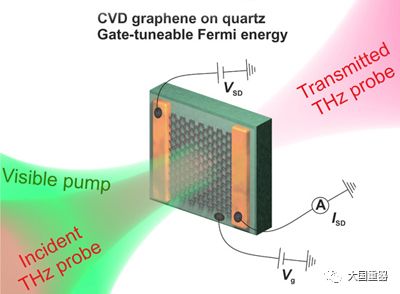A research group from the Institute of Photonics in Barcelona (ICFO) stated that the use of graphene as a photosensitive material in photodetectors can make major improvements to existing materials, and has made breakthroughs in the understanding of graphene photoconversion mechanisms. The research results have been published in the Science Advances magazine. The picture shows the experimental technology and the principle of heating conversion between bands For example, graphene can detect light of almost any wavelength, and typically produces a very fast electronic response in 1 x 10-12 seconds. Therefore, ICFO commented in its latest announcement; "In order to properly design graphene-based photodetectors, understanding the process that takes place after the graphene absorbs light is crucial." ICFO researchers Professor Frank Koppens and Prof. Klaas-Jan Tielrooij collaborated with scientists at other European research centers and stated that they have now successfully understood these processes. Conductivity rises and falls In a paper published in Science Advances, the research team gave a complete explanation of the phenomenon that graphene absorbs light and in some cases increases in conductivity and in other cases decreases in conductivity. The researchers pointed out: "For many envisaged graphene photoelectron applications, it is important to understand the subpicosecond carrier kinetics immediately after photoexcitation and the effect of photoexcitation on the conductivity (photoconductivity)." Researchers have shown that this behavior is related to the way the absorbed light energy flows to the graphene electrons: after the graphene absorbs light, the process of electron heating of the graphene occurs very quickly and has a very high efficiency. For highly doped graphene (where many free electrons are present), ultrafast electron heating results in the generation of carriers with elevated energy, ie hot carriers, which in turn leads to a decrease in the conductivity. Interestingly, for weakly doped graphene (where there is not much free electrons), electron heating leads to the production of extra free electrons and therefore to an increase in the electrical conductivity. These additional carriers are the direct result of graphene's gapless nature in which electron heating does not result in the production of additional free carriers. The simple case of photoinduced electron heating in graphene can explain many of the observed effects. In addition to describing the conductive properties of the material after light absorption, it can also explain the case of carrier doubling, in which a light-absorbing particle (photon) can indirectly generate more than one extra free electron under certain conditions. Research funding The accurate understanding of the electronic heating process in this study undoubtedly means that it will be of great help to the design and development of graphene-based light detection technology. The research was funded by the Graphene Flagship Project of the European Commission (EC) and the Mineco Young Researchers Foundation. Technical observation The papers in the Science Advances magazine abstracted the researchers' methods in detail and summarized their findings: "We distinguished two types of ultrafast photo-induced carrier heating processes: at low (equilibrium) Fermi energy (EF) ≲ 0.1eV) Under the experimental conditions, the expansion of the carrier distribution involves the conversion between bands. Under the experimental conditions of higher Fermi energy (EF≈0.15 eV), the widening of the carrier distribution involves the in-band transition. Under certain conditions At low Fermi energy conditions, additional electron-hole pairs can be generated, and hot carriers can be generated under high Fermi energy conditions. future development So how does this highly academic research translate into product and market development? The Scientific Advances article concludes: "The results of our work will lead to the direct investment in optimization of graphene-based photodetector devices."
The hendlight wiring harness apply for household appliance, automotive, motocycle, bus, bike, truck, medical equipment.
Yacenter
has experienced QC to check the products in each process, from developing
samples to bulk, to make sure the best quality of goods. Timely communication
with customers is so important during our cooperation.
If you can't
find the exact product you need in the pictures,please don't go away.Just contact me
freely or send
your sample and drawing to us.We will reply you as soon as possible.
Headlight Wiring Harness,Headlight Harness,Headlamp Wiring Harness,Headlight Wiring Kit Dongguan YAC Electric Co,. LTD. , https://www.yacentercns.com